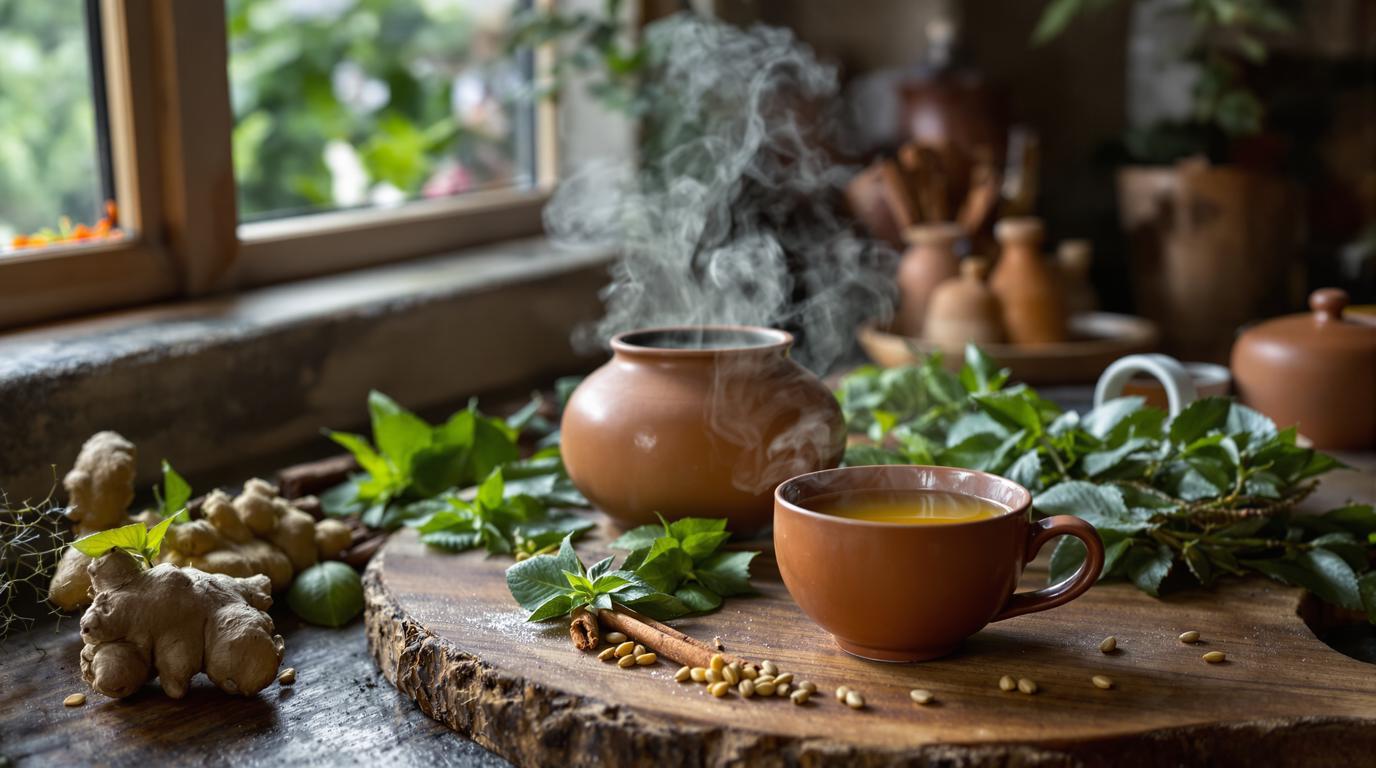I’ll never forget my first encounter with authentic Ayurvedic tea. It was during my culinary journey through Kerala, where a local grandmother invited me into her modest kitchen. “This is what keeps our family healthy through monsoon season,” she explained, crushing fragrant ginger between weathered fingers. What struck me most wasn’t just the intoxicating aroma that filled her humble space, but how this simple brew had been passed down through countless generations—a liquid testament to ancient wisdom that delivers remarkable, sustained energy without the crash of caffeine.
The Ancient Energy Secret: Ayurvedic Immunity-Boosting Tea
This isn’t just tea—it’s liquid vitality. Unlike modern energy drinks that offer a temporary jolt followed by an inevitable crash, this traditional Ayurvedic blend works with your body’s natural rhythms to enhance what practitioners call “ojas”—your fundamental life force. The combination of warming spices activates digestion (your primary energy source) while powerful antioxidants fight inflammation that often manifests as fatigue.
I’ve refined this recipe over two decades of professional cooking, staying true to tradition while making it accessible for modern kitchens. What makes this blend special is how it balances six essential tastes recognized in Ayurveda, creating harmony that can be felt throughout the body.
The Essential Ingredients
For 4 servings, you’ll need:
- 4 cups filtered water
- 2-inch piece fresh ginger, peeled and crushed
- 8-10 dark raisins
- 1 cinnamon stick (approximately 2 inches)
- 7-8 whole cloves
- 7-8 black peppercorns
- 4 green cardamom pods, lightly crushed
- 1 bay leaf
- ½ teaspoon turmeric powder (or 1-inch fresh turmeric, grated)
- 4-5 holy basil (tulsi) leaves, fresh or dried
- 1 tablespoon jaggery or 2 pitted dates
- Fresh lemon juice, to taste (optional)
The Ceremonial Preparation
I approach this recipe with the same reverence I witnessed in that Keralan kitchen:
- In a heavy-bottomed saucepan (preferably stainless steel or earthenware), combine water, crushed ginger, cinnamon, bay leaf, cloves, peppercorns, and cardamom pods.
- Bring to a rolling boil over medium-high heat, then immediately reduce to low.
- Add the turmeric powder, raisins, and holy basil. Gently simmer for 10-15 minutes, allowing the liquid to reduce by approximately one-quarter.
- Add jaggery or dates, stirring until completely dissolved.
- Remove from heat, cover, and allow to steep for an additional 3-5 minutes.
- Strain through a fine-mesh sieve into warmed mugs. Add fresh lemon juice if desired.
Chef’s Note: The true magic happens during the simmering phase. Unlike Western teas that are typically steeped, the extended gentle heat extraction activates and binds the medicinal compounds. Never rush this process by boiling vigorously—gentle bubbles are all you need.
Pro Techniques for Maximum Benefit
Temperature control is crucial. If you boil this blend aggressively, you’ll destroy the delicate aromatic compounds that carry much of the medicinal benefit. I always crush spices just before using them—never pre-ground—to maximize their potency. The same applies to ginger; crushing rather than mincing creates more surface area for extraction while preserving essential oils.
For those who can’t find jaggery, raw honey makes an excellent substitute—just add it after removing from heat to preserve its enzymes. No holy basil? While not traditional, a combination of mint and a pinch of dried basil can approximate the flavor profile.
This tea pairs beautifully with Crispy Italian spinach flatbreads for a light afternoon energy boost. For morning consumption, try alongside a slice of 30-minute homemade bread—the combination of complex carbohydrates with this spiced brew provides sustained energy for hours.
Serving Traditions & Modern Adaptations
In traditional Ayurvedic households, this tea is served warm—never iced—as cold beverages are believed to dampen digestive fire. I recommend drinking from a pottery mug for the authentic experience. The clay retains heat while allowing the tea to breathe, enhancing the aromatics with each sip.
For those seeking additional wellness options, this tea makes an excellent companion to silky broccoli soup or crispy pan-fried fish for a complete immunity-supporting meal. I’ve even incorporated this tea into pasta sauces by using it as the liquid base for unique flavor dimensions.
In my decades of culinary exploration, I’ve discovered few beverages that offer such profound benefits while delighting the senses. This isn’t just a recipe—it’s ancient wisdom in a cup, ready to transform your daily ritual into something truly energizing. As my Keralan host reminded me with a knowing smile, “Good health begins with what you drink, not just what you eat.”
